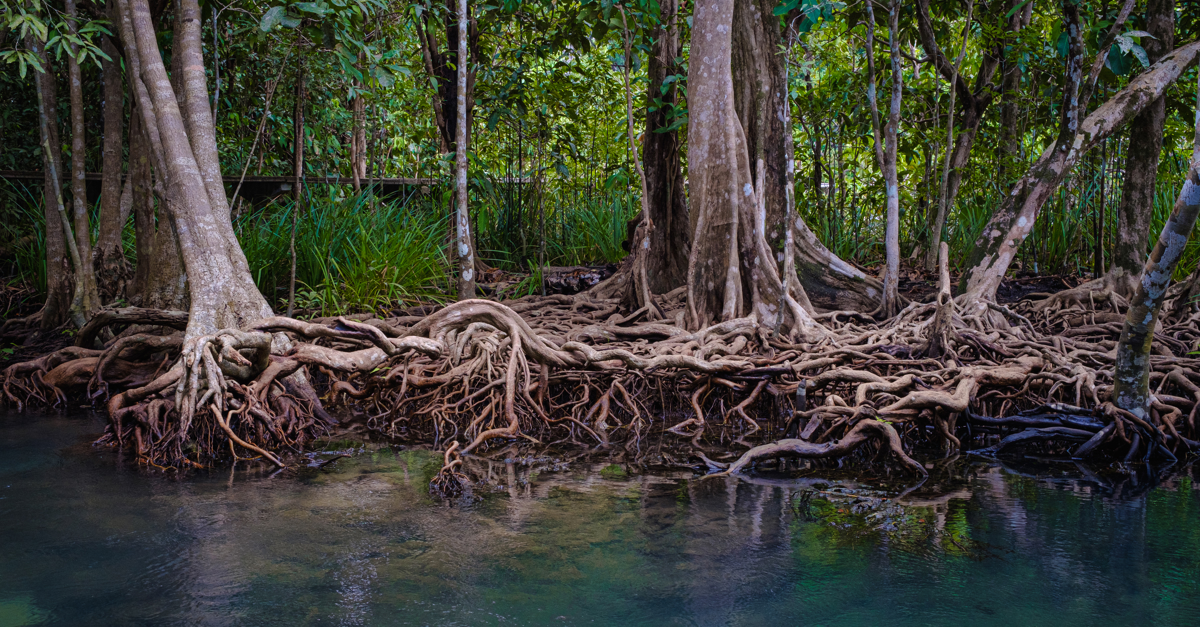
In the ever-changing space between land and sea – known as the intertidal zone – physical and chemical conditions make it difficult for life to survive. Mangroves are a species of maritime trees and shrubs that have evolved to withstand these brackish environments.
Spanning 147,000 km2 of land globally, mangrove forests fringe the coastlines of over 120 tropical and sub-tropical countries. The largest area of mangroves is found in Southeast Asia, with Indonesia accounting for more than one-fifth of the world’s mangrove forests.
The Sundarbans – which represents the world’s largest continuous mangrove forest – is globally recognised for the diverse range of ecological and socio-economic functions it provides. In fact, the Indian and Bangladeshi sections of the Sundarbans were declared World Heritage Sites by UNESCO, in 1987 and 1997 respectively.
Carbon sequestration
It is now widely accepted that significant reductions in greenhouse gas emissions cannot be achieved unless carbon capture and storage techniques, both passive and active, are employed. In 2016, the United Nations Framework Convention on Climate Change (UNFCCC) officially recognized the potential of mangroves for climate change mitigation through carbon sequestration and storage.
Owing to their high rates of primary productivity (the rate at which light is converted to energy through photosynthesis), mangroves assimilate three to four times more carbon than terrestrial forests. Some of this carbon is stored in above-ground biomass, but a significant portion is transported to the sediment through a process known as root exudation, where plant roots release organic compounds into the soil. This provides a crucial source of carbon and energy to soil microorganisms.
When soil microorganisms consume the organic compounds they release by-products such as carbon dioxide and methane, which is then absorbed and stored by the surrounding sediment. This capacity for carbon storage makes mangrove forests an important tool for mitigating climate change, as they help to remove carbon dioxide from the atmosphere and store it in a stable form below ground.
Biodiversity
Mangrove forests form an essential habitat for many marine and terrestrial species including fish, crabs, shrimp, molluscs, and birds. They provide vital nursery grounds and feeding areas for a variety of marine life, including commercially important species such as shrimp and fish, which support coastal communities' livelihoods.
As mentioned, the root systems of mangroves provide a critical substrate for microorganisms, such as bacteria and fungi, which break down organic matter and recycle nutrients, helping to maintain the ecosystem's health. As well as capturing carbon, the complex root systems also prevent erosion by trapping sediment, creating new land and expanding the forest's boundaries. This expansion creates new habitats and provides opportunities for new species to colonize, thereby enhancing biodiversity.
Beyond natural habitats, mangroves serve as a critical refuge for many species that have lost their original habitats. For example, the Yellow-Shouldered Blackbird and the Philippine Cockatoo originally lived in inland forests, but lost their habitats due to agriculture and housing developments. They are now restricted to mangrove areas and would likely be extinct if not for the mangroves providing their last refuge. Without the natural protection and places of retreat provided by mangroves, the population of these species would have dramatically decreased.
Mangroves also play a crucial role in maintaining the health of coastal ecosystems. They act as natural filters, removing pollutants and excess nutrients from the water before it flows out to the ocean. This filtering function helps to improve water quality and maintain the health of coral reefs and seagrass beds, which are essential for many marine species.
Coastal Defence
The complex root system of mangroves enables them to trap sediments and organic matter carried by rivers, leading to the accumulation of soil, land surface accretion, and even elevation due to roots growing below the surface. This unique characteristic allows some mangroves to keep pace with rising sea levels, making them naturally-occurring ecosystem engineers that form climate-resilient coasts.
During storm surges and tsunamis, mangroves can significantly reduce the impact of waves on the coast, effectively buffering the shoreline against the destructive forces of the sea. In areas where mangroves are present, damage from storm surges and tsunamis is less severe than in areas without mangroves.
More broadly, this helps to prevent soil erosion and maintain the integrity of coastal ecosystems. The root system of mangroves can extend several meters down into the sediment, which provides a strong anchor to hold the shoreline in place.
On a global scale, mangrove ecosystems are relatively small. However, they create highly-evolved ecosystems with a variety of physical and biological characteristics that make them well worth protecting.

